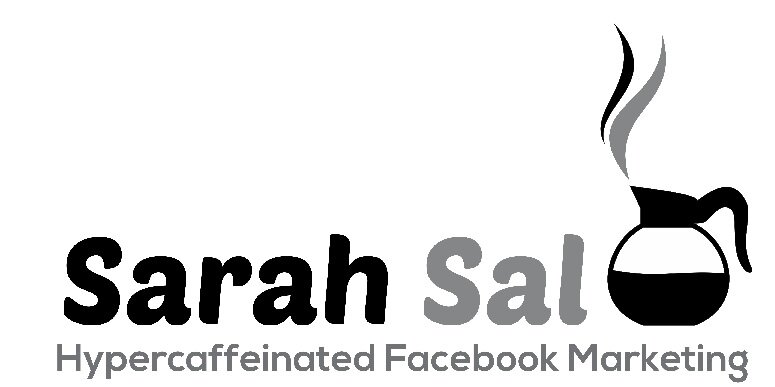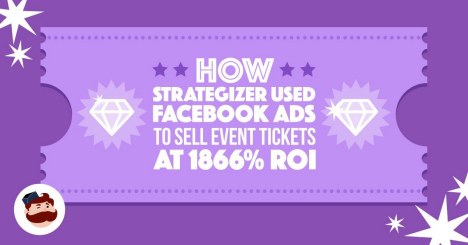In 2002 when James Caan sold the recruiting company he created, it had a turnover of around £130m (around USD 174m).
He started his business by cold calling companies and saying: “Hi, my name’s James Caan, I’m calling from Alexander Mann. We’re specialists in financial recruitment...”.
He spoke to hundreds of people, and all of them told him to get lost.
It only got better when he moved from the generic pitch to a specific angle: “I had this guy in last week, he’s at Allied Dunbar, and I think he’d be perfect for you….” And then he went on describing the candidate.
Strategyzer.com was in a similar situation.
They invested over $4,5k on Facebook ad and sold just one ticket to their workshop.
After 5 months, they got around $212,000 in sales for an ad spend of only $11,357.26. It means a return of $18.66 for each $1 spent on Facebook ads.
In this case study, I’ll share the Facebook ad strategy I used.
So many companies run generic ads: “our event is next week, hurry up...”. Strategyzer was no different.
For their first Facebook ad campaign, they just split tested audiences and different images, and the creativity looked like this:
That approach cost Strategyzer $4,433.53 in around 3 weeks, and they got only one sale in return.
Not ready to throw in the towel, we started working together to improve their ads' ROI.
What did I do and, most importantly, did my strategy work? I don't wanna sound like I'm bragging 8-) so... give a look at the image below and let the numbers speak!
How did I turn the campaign around? I used a tactic supermarkets have successfully used for years: samples. Yes, according to The Atlantic, the good 'ole direct sale technique has increased sales at supermarkets like Mash and Costco by up to 2,000 percent.
I started by studying Strategyzer's content, including case studies and business stories, and I used storytelling to write ads that gave the users a taste of what they’d learn attending the event.
Here is an example of the first ad we ran for them:
Does a long Facebook ad copy work?
I can hear many of you thinking:
1. That is a long ad copy, we’ve been told to keep it short. People don’t read long ads.
2. By spelling it out in the copy, what motivation will people have in clicking on the ad? Keep some mystery!
Well, the proof is in the pudding, those ads got sales.
A longer ad copy with smart use of storytelling has another indirect effect: it promotes is high engagement.
By putting a big chunk of content out there for everybody you give enough to create discussion. There won't be only likes, of course, some people might disagree with the content, but to do so they have to leave a comment and join the conversation, which drives engagement.
In the image below there is another ad we ran. Do you notice the 234 shares, 980 likes and the 42 comments?
The Relevance score is calculated based on the positive and negative feedbacks your ad receives from users. Positive feedback includes actions like commenting, liking, sharing and even link clicks.
While engagement is not the only factor in calculating the relevance score, Facebook recommends improving the ad text.
Why does this matter? For conversion campaigns, Ads with higher relevancy score get rewarded by Facebook both with more impressions and a lower CPM.
The importance of targeting (and retargeting)
With a single ticket to the event costing over $2199, I could not expect cold traffic sent directly to the sale page to convert well.
Lucky for us Alexander Osterwalder's work is well known, with USA Today naming his Business Model Generation among the 12 best business books of all time. With over a million copies of his book in 37 languages, we did have a big retargeting audience to target.
What we found out is that not all retargeting audiences are equal.
In our case, people that visited Strategyzer blog did not convert at the same cost of people that visited their training page, and so on.
Based on pages people visited, it allowed us to categorize them. Someone reading the blog will be familiar with their content, but on the other hand, someone visiting the training or books pages might also be interested getting some needed training.
It is really about running the ads to different audiences, and letting the numbers speak to which audience converts at what cost.
Audience saturation and ad fatigue
With over 500 million copies sold worldwide, the Harry Potter series of novels is a huge success. But even with such success, a total of 7 books was written in order to keep sales coming.J. K. Rowling did not just change the image on the book cover and hope sales will keep coming. She wrote more content.
Think of your ad as a novel. Instead of giving the same page (with maybe just a few twists) over and over again to the same audience, give them every time something new. Scrolling through the ads of your campaign should be like flipping the pages of a novel. You have to keep the audience interested.
At $2199/ticket, people will click and go to the landing page and they'll end up buying a few days or even weeks later.
A while ago I ran ads for www.clickfunnels.com, a funnel hacking event in Las Vegas. I paused the ads and reported back to them: "we’ve got a total of 11 sales". I thought that was it! But 6 days later, checking their ad account (as I did run other campaigns for them), I noticed that the total number of sales for the Vegas event increased to 21, and kept growing further a few a days later.
Facebook will attribute a sale to the day someone clicked on the ad, on the other hand, Google Analytics will attribute it to the day the user bought. In a few campaigns where I used UTM tracking, I again noticed people who clicked on a Facebook ad and ended up buying many days later.
So how do you know it is time to show the audience a new ad, given that people will click today and buy later?
If the CPC increased and the CTR dropped significantly, I took it as a sign that it was time to launch a new ad.
In the screenshot below, my CPC increased from $1.15 to $2.33, and the CTR dropped from 2.41% down to 0.71%
So I wrote a new ad text with new content in it, and CPC decreased to $0.98, while the CTR increased to 2.62%
Now I can hear someone of you thinking: “Sarah, CTR, and CPC are good, but show us the money. What about sales?”
For the London event (we also ran ads for the Boston and Berlin event) I wrote a total of 5 ads, and below you can see the sale break down for each ad.
Below is the ad that got the most sales at the cheapest cost.
You won’t know in advance which ad will convert the best, but it is about putting out multiple ads and letting the numbers speak.
Split testing, your best ally
For an event located in London/Europe, if you live in the UK, travel costs are cheaper than if you live in New Zealand (we actually got sales from Thailand, New Zealand, and Argentina).
When running ads, I don’t recommend making a huge number of split tests, as the algorithm can optimize and learn from past conversions. With that said, the algorithm needs 50 conversions/week to be able to optimize and learn who to show the ad to (if you are not getting 50 sales/week, Facebook recommends you to optimize for adds-to-cart or page views instead of purchase ).
Since we know that location will influence sales, as well as which warm audience the user is part of, will a past customer be more likely to buy than someone who read the blog?
We decided to split test both based on locations and custom audiences. And that is where a tool like AdEspresso is a huge time saver.
Location wise I decided to have separate adsets for people inside and outside of Europe. As you can see below, we got 35 sales in Europe with a CPA of $92.
While we’ve got 9 sales outside of Europe at a CPA of $275.78, in our case since the global CPA was good, we were happy to pay for the extra sales coming from outside of Europe.
Of course, there is no general rule that says a nearby location will always convert better, it is about testing.
For the clickFunnel event, on the other hand, I assumed that neighboring states to Nevada or cities with direct flights to LasVegas will convert better. Honestly, wouldn’t an 11-hour flight make it harder for you to attend?
Well, I was wrong, the cost per sale was of $99.29 for neighboring states or cities with direct flights.
And $38.93 for locations I assumed they will be less likely to want to make the trip. Final Thoughts
And $38.93 for locations I assumed they will be less likely to want to make the trip.
Final Thoughts
In 2008 Anthony Bourdain visited a Chinese food stall called Xi'an Famous Foods. The publicity helped grow the business into a restaurant chain that owns 11 restaurants and generate millions in revenues. On the other side, the famous travel vlogger Lost LeBlanc
mention how in Hanoi he was followed by a pushy salesman, to the point he needed to seek refuge inside a hostel.
You want to avoid being the pushy salesman.
Back to the Anthony Bourdain example, after 14 years on tv, and over 285 tv episodes, people still watch it as each new episode will give you something new.
To combat ad fatigue your ads need to provide the audience with new content.
A good ad is one that does not look like an ad, it is also an ad that makes the user think: "Even if I did not click on the ad, just by reading the ad text, I’ve learned something new."
Selling $2199 tickets to a live event via Facebook ads is not easy. At first, Strategyzer.com was losing money on Facebook ads. Then, by writing ads that didn’t look like an ad but more like useful content, they managed to achieve a +1866% ROI.
Even if you don’t promote offline events or sell high ticket items, by learning their copywriting and ad strategy you can dramatically improve your results.
Hey, Want More Juicy Content Like This? Get It in Your Inbox!
There's only so much I can share in a single blog post. If you love this content, join my email list. You'll get similar insights drip-fed to you one email at a time. Plus, I'll send you free case studies packed with tips to help you get the best results from your ads.
Unveil the rest of my secrets by signing up here. Go on, you know you want to!















